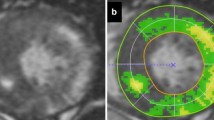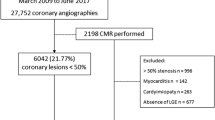Abstract
To determine the prognosis of a myocardial scar assessed by a late gadolinium enhancement (LGE) technique of cardiac magnetic resonance (CMR) in hypertensive patients with known or suspected coronary artery disease (CAD). Patients with systemic hypertension with known or suspected CAD without a clinical history of myocardial infarction were enrolled. All patients underwent CMR for assessment of cardiac function and LGE. Prognostic data was determined by the occurrence of a hard cardiac endpoint, defined as cardiac death or a non-fatal myocardial infarction, or major adverse cardiac events (MACEs), defined as cardiac death, a non-fatal myocardial infarction, or hospitalization due to heart failure, unstable angina, or life-threatening ventricular arrhythmia. A total of 1,644 patients were enrolled; 48% were males and the mean age was 65 ± 11 years. The average follow-up time was 863 ± 559 days. Four hundred fifty-three (28%) patients had LGE. LGE was the strongest and most independent predictor for hard events and MACEs with hazard ratios of 4.77 and 3.38, respectively. Other independent predictors of hard events and MACEs were left ventricular ejection fraction and mass, the use of a beta-blocker, and a history of heart failure. The risk of cardiac events increased as the extent of LGE increased; the hazard ratio was 12.74 for hard events for those with a LGE >20% of the myocardium. LGE is the most important and independent predictor for cardiac events in hypertensive patients with known or suspected CAD.



Similar content being viewed by others
References
Barbier CE, Bjerner T, Johansson L et al (2006) Myocardial scars more frequent than expected: magnetic resonance imaging detects potential risk group. J Am Coll Cardiol 48(4):765–771
Moon JC, De Arenaza DP, Elkington AG et al (2004) The pathologic basis of Q-wave and non-Q-wave myocardial infarction: a cardiovascular magnetic resonance study. J Am Coll Cardiol 44(3):554–560
Wagner A, Mahrholdt H, Holly TA et al (2003) Contrast-enhanced MRI and routine single photon emission computed tomography (SPECT) perfusion imaging for detection of subendocardial myocardial infarcts: an imaging study. Lancet 361(9355):374–379
Ibrahim T, Bulow HP, Hackl T et al (2007) Diagnostic value of contrast-enhanced magnetic resonance imaging and single-photon emission computed tomography for detection of myocardial necrosis early after acute myocardial infarction. J Am Coll Cardiol 49(2):208–216
Mancia G, De Backer G, Dominiczak A et al (2007) 2007 Guidelines for the management of arterial hypertension: the task force for the management of arterial hypertension of the European society of hypertension (ESH) and of the European society of cardiology (ESC). Eur Heart J 28(12):1462–1536
Krittayaphong R, Sheps DS (1996) Relation between blood pressure at rest and perception of angina pectoris during exercise testing. Am J Cardiol 77(14):1224–1226
Aguilar D, Goldhaber SZ, Gans DJ et al (2004) Clinically unrecognized Q-wave myocardial infarction in patients with diabetes mellitus, systemic hypertension, and nephropathy. Am J Cardiol 94(3):337–339
Ho KK, Pinsky JL, Kannel WB et al (1993) The epidemiology of heart failure: the Framingham study. J Am Coll Cardiol 22:6A–13A
Kwong RY, Chan AK, Brown KA et al (2006) Impact of unrecognized myocardial scar detected by cardiac magnetic resonance imaging on event-free survival in patients presenting with signs or symptoms of coronary artery disease. Circulation 113(23):2733–2743
Wu KC, Weiss RG, Thiemann DR et al (2008) Late gadolinium enhancement by cardiovascular magnetic resonance heralds an adverse prognosis in nonischemic cardiomyopathy. J Am Coll Cardiol 51(25):2414–2421
Kwong RY, Sattar H, Wu H et al (2008) Incidence and prognostic implication of unrecognized myocardial scar characterized by cardiac magnetic resonance in diabetic patients without clinical evidence of myocardial infarction. Circulation 118(10):1011–1020
Alpert JS, Thygesen K, Antman E et al (2000) Myocardial infarction redefined—a consensus document of the joint European society of cardiology/American college of cardiology committee for the redefinition of myocardial infarction. J Am Coll Cardiol 36(3):959–969
Sokolow M, Lyon TP (1949) The ventricular complex in left ventricular hypertrophy as obtained by unipolar precordial and limb leads. Am Heart J 37(2):161–186
Cerqueira MD, Weissman NJ, Dilsizian V et al (2002) Standardized myocardial segmentation and nomenclature for tomographic imaging of the heart: a statement for healthcare professionals from the cardiac imaging committee of the council on clinical cardiology of the American heart association. Circulation 105(4):539–542
Krittayaphong R, Saiviroonporn P, Boonyasirinant T et al (2007) Accuracy of visual assessment in the detection and quantification of myocardial scar by delayed-enhancement magnetic resonance imaging. J Med Assoc Thai 90(Suppl 2):1–8
Sheffield D, Krittayaphong R, Go BM et al (1997) The relationship between resting systolic blood pressure and cutaneous pain perception in cardiac patients with angina pectoris and controls. Pain 71(3):249–255
Sheps DS, Ballenger MN, De Gent GE et al (1995) Psychophysical responses to a speech stressor: correlation of plasma beta-endorphin levels at rest and after psychological stress with thermally measured pain threshold in patients with coronary artery disease. J Am Coll Cardiol 25(7):1499–1503
Pierdomenico SD, Bucci A, Costantini F et al (1998) Circadian blood pressure changes and myocardial ischemia in hypertensive patients with coronary artery disease. J Am Coll Cardiol 31(7):1627–1634
Chobanian AV, Bakris GL, Black HR et al (2003) The seventh report of the joint national committee on prevention, detection, evaluation, and treatment of high blood pressure: the JNC 7 report. JAMA 289(19):2560–2572
Smith SC Jr, Allen J, Blair SN et al (2006) AHA/ACC guidelines for secondary prevention for patients with coronary and other atherosclerotic vascular disease: 2006 update endorsed by the national heart, lung, and blood institute. J Am Coll Cardiol 47(10):2130–2139
Grothues F, Moon JC, Bellenger NG et al (2004) Interstudy reproducibility of right ventricular volumes, function, and mass with cardiovascular magnetic resonance. Am Heart J 147(2):218–223
Alfakih K, Bloomer T, Bainbridge S et al (2004) A comparison of left ventricular mass between two-dimensional echocardiography, using fundamental and tissue harmonic imaging, and cardiac MRI in patients with hypertension. Eur J Radiol 52(2):103–109
Dickstein K, Cohen-Solal A, Filippatos G et al. (2008) ESC Guidelines for the diagnosis and treatment of acute and chronic heart failure 2008: the task force for the diagnosis and treatment of acute and chronic heart failure 2008 of the European society of cardiology developed in collaboration with the heart failure association of the ESC (HFA) and endorsed by the European society of intensive care medicine (ESICM). Eur Heart J 29(19):2388–2442
Schiller NB, Shah PM, Crawford M et al. (1989) Recommendations for quantitation of the left ventricle by two-dimensional echocardiography. American society of echocardiography committee on standards, subcommittee on quantitation of two-dimensional echocardiograms. J Am Soc Echocardiogr 2(5):358–367
Okin PM, Devereux RB, Jern S et al (2004) Regression of electrocardiographic left ventricular hypertrophy during antihypertensive treatment and the prediction of major cardiovascular events. JAMA 292(19):2343–2349
Author information
Authors and Affiliations
Corresponding author
Rights and permissions
About this article
Cite this article
Krittayaphong, R., Boonyasirinant, T., Chaithiraphan, V. et al. Prognostic value of late gadolinium enhancement in hypertensive patients with known or suspected coronary artery disease. Int J Cardiovasc Imaging 26 (Suppl 1), 123–131 (2010). https://doi.org/10.1007/s10554-009-9574-7
Received:
Accepted:
Published:
Issue Date:
DOI: https://doi.org/10.1007/s10554-009-9574-7




